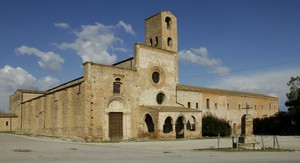Morro d'Oro
| Informazioni |
|---|
| Mappa e contatti |
Spanning the Vomano and the Tordino rivers, this little village has mediaeval origins as its typical 15th-century fortified structure suggests.
Worthwhile are the Parish Church of S.Salvatore, built in the14th century and later restored (inside a terracotta 16th-century statue of the Madonna, altars and baroque organs can be admired) and in the surrounding countryside the ex-convent of S.Antonio Abate with its 1300 portal.
Finally, be sure to visit the major complex of S.Maria di Propezzano. The legend says that this church was constructed after the apparition of the Madonna on the 10th of May of the year 715. But the mysteries linked to this church regard mostly the actual construction of the whole complex; the oldest part was inexplicably initiated in Gothic style and than completed in Roman style.
The fašade is constituted of three sections all of different heights. The section on the right is part of the convent. The central section includes a porch with three arches, that stretches over the portal and the remains of a series of 15th-century frescos; over the porch the fašade is decorated with an oculus and a plain rose window. The right section bears another portal called Porta Santa that remains closed except on the 10th of may and on Ascension Day.
Right behind rises the quadrangular Bell Tower.
Inside the convent (not always open to public) encloses a quadrangular 16th-century cloister, characterised by two series of arches and a well in its centre. In the lunettes of the cloister, rests of 17th-century frescos, executed by the polish painter Sebastiano Majewski, can still be seen and in the refectory, 16th-century frescos illustrate the legend of the foundation of this religious complex.
Among the events that take place in Morro D'Oro the Premio internazionale per fisarmonica "Premio Bizzarri" is certainly worthwhile. Over the years it has become a traditional summer appointment for the population of Teramo, traditionally found of popular music, but also for tourists fascinated by the evocative rhythms of this instrument.

















